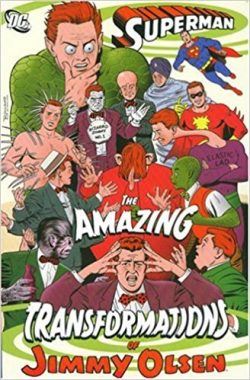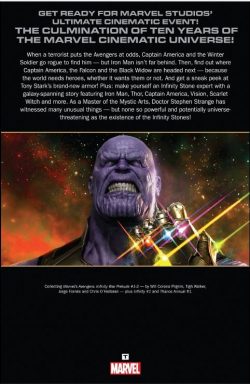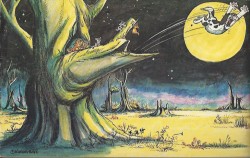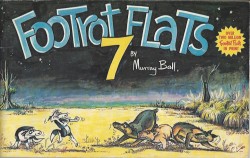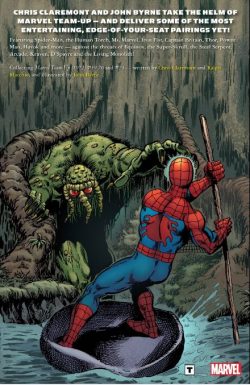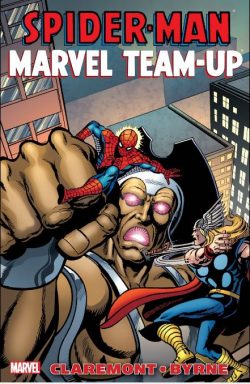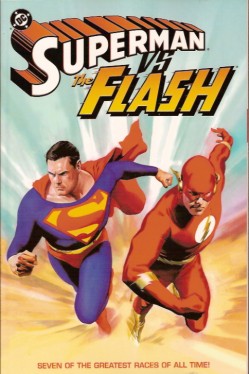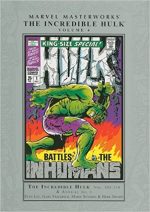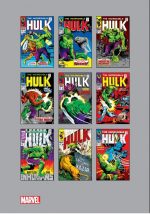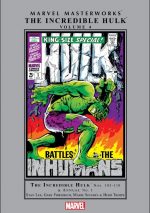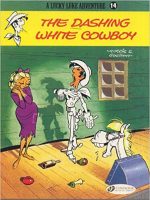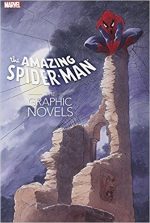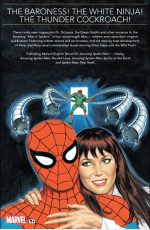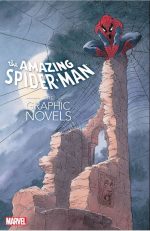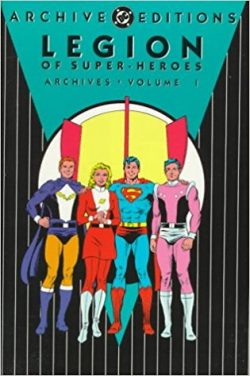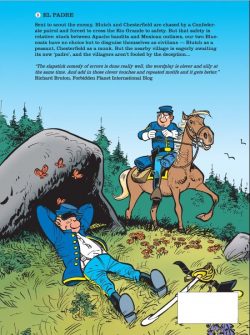
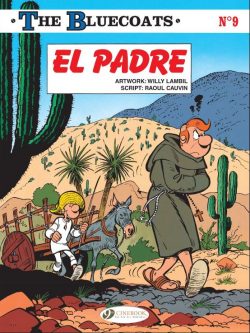
By Willy Lambil & Raoul Cauvin translated by Jerome Saincantin (Cinebook)
ISBN: 978-1-84918-286-7
Les Tuniques Bleues began in 1968; an occasional comedy western strip created by Louis “Salvé†Salvérius & Raoul Colvin – who has solo-written every best-selling volume since. The feature was created to replace Western wonder man Lucky Luke when the laconic lone gunslinger defected from weekly anthology Le Journal de Spirou to comic rival Pilote.
His rapidly-rendered replacements swiftly became one of the most popular bande dessinée stars on the Continent…
Salvé was a cartoonist of the Gallic big-foot/big-nose humour style, and when he died suddenly in 1972, his replacement – Willy “Lambil†Lambillotte – gradually moved towards an edgier, more realistic (although still broadly comedic) illustrative manner. Lambil is Belgian-born (in 1936) and, after studying Fine Art in college, joined publishing giant Dupuis as a letterer in 1952.
Born in 1938, scripter Raoul Cauvin is also Belgian and studied Lithography before joining Dupuis’ animation department in 1960. He soon discovered his true calling as a comedy writer and began a glittering and prolific career at Spirou.
In addition to Bluecoats Cauvin has written dozens of other long-running, award winning series including Cédric, Les Femmes en Blanc and Agent 212: amassing more than 240 separate albums in total. The Bluecoats alone have sold more than 15 million copies worldwide.
The sorry protagonists of the show are Sergeant Cornelius Chesterfield and Corporal Blutch, a pair of worthy fools in the manner of Laurel and Hardy: hapless, ill-starred US cavalrymen posted to the wild frontier and various key points of mythic America.
The original format was single-page gags centred about an Indian-plagued cavalry fort, but with second volume ‘Du Nord au Sud’ (North and South) the sad-sack soldiers went back East to fight in the American Civil War.
That origin was discarded and rewritten a decade later, finally and canonically describing how the chumps were drafted into the military during the war as seen in previous volume Auld Lang Blue. All subsequent adventures – despite ranging far beyond the traditional environs of America and taking in a lot of genuine and thoroughly researched history – are set within the timeframe of the Secession conflict.
Les Tuniques Bleues: El Padre was first seen on the continent in 1980, serialised in Spirou #2192-2202. Originally the 17th Euro-compilation, it comprises Cinebook’s 9th compellingly charming Bluecoats translated album of 60 thus far released in French…
Blutch is your average whinging little-man-in-the street: work-shy, mouthy, devious and especially critical of the army and its inept commanders. Ducking, diving, feigning death and even deserting whenever he can, he’s you or me – except sometimes he’s quite smart and heroic if no other, easier, option is available.
Chesterfield is a big burly man; an apparently ideal career soldier who has passionately bought into all the patriotism and esprit-de-corps of the Military. He is brave, never shirks his duty and wants to be a hero. He also loves his cynical little pal. They quarrel like an old married couple, fight like brothers but simply cannot agree on the point and purpose of the horrendous war they are trapped in…
It opens on the Rio Grande as our heroes are pursued by a determined party of Confederate troops. The pair have stumbled upon critical military information and the Greycoats are resolved they will not get back to their own lines…
With no other options, Chesterfield and Blutch cross into Mexico, painfully aware what might happen if they are captured by the nation’s own army, or – worse yet – its rampaging bandits…
With the Rebs posted all along the US riverbank, the lads have no choice but to head inland and eventually – with Blutch whining all the way – are forced to make camp. It’s actually a ploy to distract the vigilant Southern soldiery, but instead draws the attention of a roaming band of Indian renegades, forcing the Bluecoats even further south and into the clothing of a murdered monk and peon they discover near an abandoned mule cart.
Dreading the prospect of Mexican prison, the lads seek another river crossing but are quickly captured by Apache outlaw Jacomino before being saved by an even more deadly murdering cutthroat…
Sadistic but (sort of) devout bandito El Señor Diaz urgently needs a priest. He has subjugated a local village for his own nefarious purposes, but the Peones are refusing his demands for food and tribute until their new overlord replaces their recently murdered holy father…
The obviously-Americano Padre will have to do and with the help of the villagers – who aren’t fooled for a moment by the feisty, two-fisted cleric in a badly-fitting, blood-stained robe – Chesterfield goes about his secular and temporal duties.
Father Chesterfield’s plan is to keep the peons safe until he can get back to the war, despite the constant harassment of Jacomino’s monk-hating band, but events cascade out of control once he learns that Diaz has a hidden treasure that will earn him vast wealth and a constant supply of weapons and ammunition from the Bluecoat Army…
A little dutiful prying by Blutch exposes the horrific secret: the prize is Emily Appleton, daughter of his commanding colonel and the blithely unaware object of the bluff sergeant’s unrequited affection…
With no other option, the enraged soldier resolves that he and Blutch will steal her back and make a break for the border. As usual the plan almost works but before too long both Diaz and Jacomino are in hot in pursuit even as the confederates await at the river’s edge for the fugitives.
If there was ever a moment for a last-minute cavalry rescue this would be it…
Historically authentic, always in good taste despite an uncompromising portrayal of violence, the attitudes expressed by the down-to-earth pair never make battle anything but arrant folly and, like the hilarious yet insanely tragic war memoirs of Spike Milligan, these are comedic tales whose very humour makes the occasional moments of shocking verity doubly powerful and hard-hitting. Nevertheless, the scope for light-hearted, hot-blooded adventure is always high and this wild ride is also is heavy on comedy too: a fun, informative, beautifully realised and eminently readable yarn to appeal to the best, not worst, of the human spirit.
© Dupuis 1981 by Lambil & Cauvin. English translation © 2015 Cinebook Ltd. All rights reserved.

